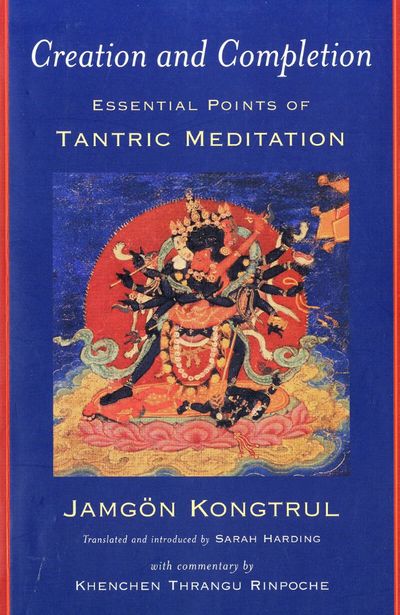
Creation and Completion represents some of the most profound teachings of Jamgön Kongtrul (1813-99), one of the true spiritual and literary giants of Tibetan history. Though brief, it offers a lifetime of advice for all who wish to engage in-and deepen-the practice of tantric Buddhist meditation.
The original text, beautifully translated and introduced by Sarah Harding, is further brought to life by an in-depth commentary by the contemporary master Thrangu Rinpoche. Key Tibetan Buddhist fundamentals are quickly made clear, so that the reader may confidently enter into tantra’s oft-misunderstood “creation” and “completion” stages.
In the creation stage, practitioners visualize themselves in the form of buddhas and other enlightened beings in order to break down their ordinary concepts of themselves and the world around them. This meditation practice prepares the mind for engaging in the completion stage, where one has a direct encounter with the ultimate nature of mind and reality. (Source: Wisdom Publications)
- Foreword vii
- Preface ix
- Technical Note xi
- Introduction 1
- Buddhism 2
- Three Turnings of the Wheel of Dharma 2
- Buddhism in Tibet 6
- Deity Practice 7
- The Guru 11
- Creation Stage 13
- Completion Stage 16
- Jamgön Kongtrul 20
- Literary Works 24
- The Root Text in Tibetan and English 27
- The Essential Points of Creation and Completion That Will Benefit the
Beginner Who Has Entered the Path 29
- Commentary by Khenchen Thrangu Rinpoche 83
- Introduction 83
- Essential Points for Approaching the Path 84
- Essential Points for Traversing the Path 94
- Purification 106
- The Emergence of Confusion 120
- Working with Confusion 134
- Cultivating Lucidity 141
- Notes 155
- Bibliography 177
- Index 181
The Tibetan Text translated here is a concise yet thorough exposition of the essentials of Tibetan Buddhist meditation practice by one of the most brilliant minds of that tradition, Jamgön Kongtrul Lodrö Thaye (1813-99). The Tibetan title of the text is lam zhugs kyi gang zag las dangpo pa la phan pai bskyed rdzogs kyi gnad bsdus, "The Essential Points of Creation and Completion That Will Benefit the Beginner Who Has Entered the Path." It is known to Tibetans simply as Kye Dzog Ne Dü (bskyed rdzogs gnad bsdus), or "Essential Points of Creation and Completion." Creation (or development) and completion (or perfection)[1] refer to the two stages of meditation involving deity visualization practice, a meditation technique for which Tibetan Buddhism is widely known. The text is not a specific meditation in itself, but rather describes the meaning and effect of such practice, and in doing so the essential Buddhist outlook on the nature of mind and reality. It describes with masterful clarity the profound view and vast method within which meditation practice must occur.
Jamgön Kongtrul designed this text as a guide to meditation practice. It is written entirely in verse, in the style of the songs of realization and other inspirational spiritual literature of Tibet, following a very similar tradition in ancient India. It is not an in-depth analysis or scholarly treatise. Jamgön Kongtrul, a masterful scholar, was above all interested in the actual application of the teachings in meditation. His intention in this text was to convey just what was necessary for effective practice. The intention in translating and publishing it is the same: simply to make it available for people interested in Buddhist practice. Although each verse warrants a volume of commentary, this might just result in obscuring the essential points. So what is offered here is a minimum of commentary, just enough to provide some context.



